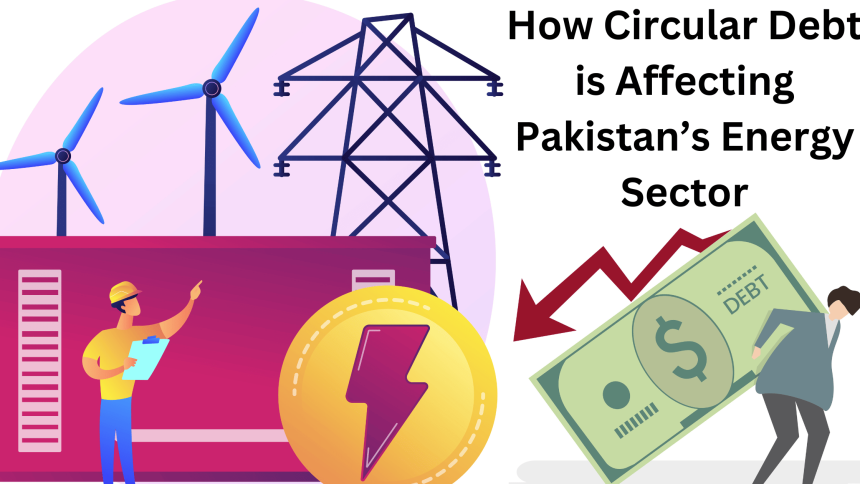
How Circular Debt is Affecting Pakistan’s Energy Sector
Circular debt is a major problem in Pakistan’s energy sector that causes power outages, high costs, and environmental damage. This blog post explains the causes, consequences, and solutions of circular debt.
2023-09-12 17:55:05 - Laiba Rafiq
Pakistan’s energy sector is grappling with an issue known as debt. This refers to the accumulation of bills, among stakeholders involved in the power supply chain. Circular debt creates a cycle that hampers the stability and operational efficiency of the power sector leading to power shortages load shedding and subpar service quality.
What Triggers Circular Debt?
Circular debt can be attributed to factors including:
1. Discrepancy between tariffs and costs:
The tariffs imposed by power distribution companies (DISCOs) often fall short of covering the costs associated with power generation and transmission. Consequently, DISCOs face revenue shortfalls which prevent them from paying power producers (IPPs) and the National Transmission and Dispatch Company (NTDC). As a result, IPPs and NTDC also experience strain making it difficult for them to cover expenses related to fuel procurement and maintenance. This ultimately diminishes their capacity for power generation while driving up expenses.
2. Recovery methods and billing systems:
DISCOs encounter challenges when attempting to recover full payment amounts from consumers due to issues, like meters, erroneous billing practices, corruption, theft, or non-payment. Based on a report, from the Ministry of Finance¹ it was found that in FY 2018 the average recovery rate for DISCOs stood at 89.6% while losses averaged 18.3%. This implies that 71.3% of the electricity supplied was actually paid for by consumers.
3. Subsidies and delayed payments:
Subsidies and delayed payments have played a role in exacerbating the issue. To ensure tariffs the government grants subsidies to consumer categories like domestic agricultural and industrial users. However, these subsidies are often not fully disbursed on time resulting in a disparity between notified tariffs. Additionally, the government itself has payments to settle with the power sector for its electricity consumption by public sector enterprises, defense establishments, and railways. These delayed payments contribute to the burden of debt.
4. Fluctuation in fuel prices:
Another contributing factor is Pakistan’s reliance on imported oil and gas for power generation. This dependency makes it susceptible to fluctuations in fuel prices and exchange rates. When fuel prices rise, does the cost of power generation, however, tariffs are not adjusted accordingly to cover these increased costs. Consequently, this creates a gap between revenues and expenses, within the power sector.
What are the Implications of Debt?
Circular debt has repercussions, for both Pakistan’s economy and society including:
1. Power disruptions and load shedding:
The power sector, unable to function at its capacity due to debt struggles to meet the increasing demand for electricity. Consequently, frequent power outages and load-shedding activities negatively impact citizen's quality of life.
2. Increased borrowing costs:
Circular debt amplifies the obligations of power sector entities forcing them to seek loans from banks and other sources to meet expenses. This results in interest payments and debt servicing costs further diminishing profitability and creditworthiness.
3. Limited investment in the power sector:
Circular debt discourages investors from engaging in the power sector due to uncertainties surrounding payment risks. This impedes the development of power projects and upgrades to existing infrastructure for enhancing generation capacity and sector efficiency.
4. Environmental degradation:
The presence of debt obstructs the adoption of renewable energy sources like solar, wind, and hydropower. Pakistan’s continued reliance on fuels, for electricity generation contributes significantly to greenhouse gas emissions and exacerbates climate change concerns.
How to Solve the Issue of Circular Debt?
The solution, to debt requires a coordinated approach that involves various stakeholders. These include:
1. Reforming tariffs:
The government needs to rationalize tariffs so that they accurately reflect the cost of power generation and transmission. Tariffs should be periodically revised to account for changes in fuel prices and exchange rates. Gradually phasing out subsidies and targeting them towards the vulnerable segments of society is also crucial.
2. Enhancing recovery and billing systems:
Power distribution companies (DISCOs) should improve their recovery and billing systems by implementing meters eliminating corruption cracking down on theft and enforcing penalties for non-payment. Improving customer service and complaint resolution mechanisms will also contribute to increasing consumer satisfaction and trust.
3. Clearing dues:
It is essential for the government to promptly clear its dues to power sector entities. Timely payment of subsidies and other obligations should be ensured to prevent arrears from accumulating.
4. Diversifying the energy mix:
Pakistan can address debt by diversifying its energy mix through increased utilization of energy sources such, as solar, wind, hydro, biomass, etc. These sources are not cheaper but cleaner and more sustainable compared to fossil fuels. Moreover, relying less on imported oil and gas can help save foreign exchange reserves.
By adopting these measures, we can effectively tackle debt while promoting a more sustainable energy sector in Pakistan. Improving governance and ensuring accountability are crucial, in the power sector. The government needs to strengthen regulations promote transparency and healthy competition and encourage partnerships between private entities. It is also important for the government to closely monitor the performance and financial stability of power sector organizations and take action whenever required. Dealing with debt is an issue that demands immediate attention and action. By addressing the causes and implementing solutions Pakistan can overcome its energy crisis and make significant progress, towards achieving its economic and social objectives.
